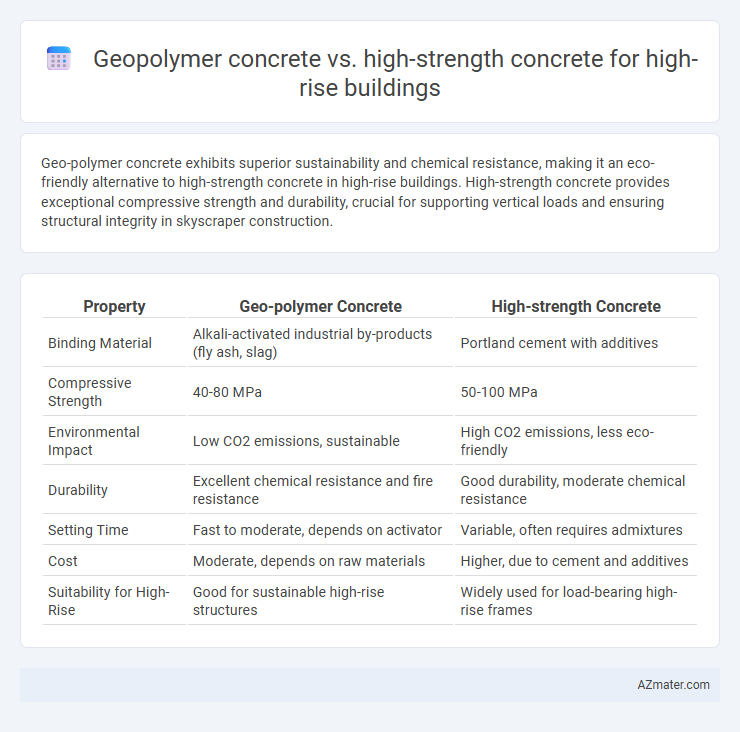Geo-polymer concrete exhibits superior sustainability and chemical resistance, making it an eco-friendly alternative to high-strength concrete in high-rise buildings. High-strength concrete provides exceptional compressive strength and durability, crucial for supporting vertical loads and ensuring structural integrity in skyscraper construction.
Table of Comparison
| Property | Geo-polymer Concrete | High-strength Concrete |
|---|---|---|
| Binding Material | Alkali-activated industrial by-products (fly ash, slag) | Portland cement with additives |
| Compressive Strength | 40-80 MPa | 50-100 MPa |
| Environmental Impact | Low CO2 emissions, sustainable | High CO2 emissions, less eco-friendly |
| Durability | Excellent chemical resistance and fire resistance | Good durability, moderate chemical resistance |
| Setting Time | Fast to moderate, depends on activator | Variable, often requires admixtures |
| Cost | Moderate, depends on raw materials | Higher, due to cement and additives |
| Suitability for High-Rise | Good for sustainable high-rise structures | Widely used for load-bearing high-rise frames |
Introduction to Geo-Polymer and High-Strength Concrete
Geo-polymer concrete is an innovative material made from industrial by-products like fly ash and slag, offering excellent durability and reduced carbon footprint compared to traditional cement. High-strength concrete, characterized by compressive strength typically above 6,000 psi, provides superior load-bearing capacity essential for high-rise structures. Both materials support high-rise construction by enhancing structural integrity and sustainability, with geo-polymer concrete offering environmentally friendly benefits while high-strength concrete ensures proven performance under heavy loads.
Key Material Composition Differences
Geopolymer concrete primarily uses industrial by-products such as fly ash or slag activated by alkaline solutions, reducing reliance on traditional Portland cement, whereas high-strength concrete relies heavily on high cement content combined with fine aggregates and chemical admixtures to achieve greater compressive strength. The geopolymer matrix offers enhanced resistance to chemical attacks and lower carbon emissions, contrasting with the high calcium silicate hydrate structure in high-strength concrete that provides superior mechanical performance. These compositional differences influence durability, sustainability, and load-bearing capacity, critical factors in high-rise building construction.
Environmental Impact and Sustainability
Geopolymer concrete offers significant environmental advantages over high-strength concrete by utilizing industrial by-products like fly ash and slag, reducing carbon dioxide emissions by up to 80% during production. High-strength concrete, primarily cement-based, generates higher embodied carbon, contributing more to global warming. The sustainability of geopolymer concrete makes it increasingly favorable for high-rise buildings aiming to minimize their ecological footprint while maintaining structural integrity.
Mechanical Properties and Strength Performance
Geo-polymer concrete exhibits enhanced mechanical properties with higher compressive strength and superior resistance to chemical attacks compared to conventional high-strength concrete, making it ideal for high-rise building applications. The inorganic polymer binder in geo-polymer concrete provides excellent durability and reduced thermal conductivity, contributing to improved long-term structural performance. High-strength concrete offers significant load-bearing capacity and improved modulus of elasticity but often requires energy-intensive production and can be more susceptible to micro-cracking under sustained loads.
Durability and Longevity in High-Rise Applications
Geopolymer concrete exhibits superior chemical resistance and reduced permeability compared to high-strength concrete, enhancing durability in high-rise building environments exposed to aggressive atmospheres and urban pollutants. Its thermal stability and reduced shrinkage contribute to prolonged structural integrity, minimizing maintenance costs over the building's lifecycle. High-strength concrete, while offering significant compressive strength, tends to be more susceptible to cracking and sulfate attack, potentially compromising longevity in long-term high-rise applications.
Workability and Construction Techniques
Geo-polymer concrete offers superior workability due to its lower water demand and enhanced flowability, making it ideal for intricate high-rise construction techniques such as pumped concrete and slip-forming. High-strength concrete, while providing exceptional compressive strength above 60 MPa, requires precise mixing and curing conditions to maintain workability, often necessitating admixtures like superplasticizers for effective placement in tall structures. Construction methods for geo-polymer concrete benefit from faster setting times and reduced thermal cracking risks, enabling more efficient layer-by-layer construction compared to the longer curing periods typical of conventional high-strength concrete.
Cost Analysis and Economic Considerations
Geo-polymer concrete offers significant cost savings over high-strength concrete in high-rise building construction due to lower raw material expenses and reduced energy consumption during production. The utilization of industrial by-products like fly ash and slag in geo-polymer mixes decreases dependency on expensive Portland cement, further minimizing overall project costs. Economic considerations also highlight reduced carbon taxes and long-term maintenance expenses with geo-polymer concrete, enhancing its financial viability compared to traditional high-strength concrete.
Fire and Chemical Resistance Comparison
Geo-polymer concrete exhibits superior fire resistance due to its inorganic polymer matrix that remains stable at temperatures exceeding 1000degC, reducing spalling and structural degradation in high-rise buildings. High-strength concrete, while possessing enhanced compressive strength, generally shows lower thermal stability and is more prone to spalling under fire exposure, compromising structural integrity. Chemically, geo-polymer concrete offers excellent resistance to acids, alkalis, and sulfates, outperforming traditional high-strength concrete, which is susceptible to chemical attack that can accelerate reinforcement corrosion and concrete deterioration.
Standards, Codes, and Global Adoption
Geo-polymer concrete, governed by standards such as ASTM C1157 and emerging IS 15878, offers sustainable alternatives with growing acceptance in regions focused on reducing carbon footprint. High-strength concrete, compliant with widely recognized codes like ACI 318 and Eurocode 2, remains the global benchmark for structural reliability in high-rise construction due to its predictable performance. Adoption of geo-polymer concrete is increasing in Asia and Australia, while high-strength concrete maintains dominance worldwide, supported by comprehensive regulatory frameworks ensuring safety and durability.
Future Prospects in High-Rise Construction
Geo-polymer concrete offers significant environmental benefits and excellent fire resistance, positioning it as a sustainable alternative for future high-rise construction. High-strength concrete remains favored for its proven structural reliability and ability to support taller, slender buildings with reduced material use. Emerging innovations integrating geo-polymer technology with high-strength formulations indicate a promising synergy for next-generation skyscrapers emphasizing durability and eco-efficiency.

Infographic: Geo-polymer concrete vs High-strength concrete for High-rise building
 azmater.com
azmater.com